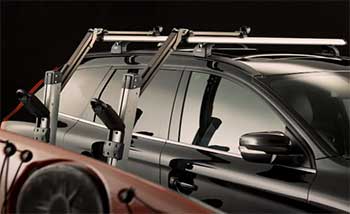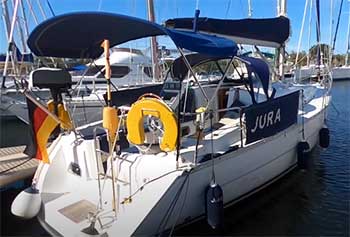The Thule Hullavator is one of the most popular kayak roof racks on the market. This vertically rotating design allows easy loading and unloading without having to lift the kayak over your head.
However, as with any product, the Hullavator has some drawbacks that savvy buyers should be aware of. In this comprehensive guide, we’ll outline the key problems to watch out for if you’re considering buying a Thule Hullavator.
Problems With Thule Hullavator

Here is a list of those issues:
- Difficult to Properly Align and Install
- Kayak Can Loosen During Transport
- Difficult to Load by Yourself
- Limited Side-to-Side Adjustability
- Durability Issues in Saltwater Environments
- High Initial Cost
- Questionable Security
- Aerodynamic Drag
- Cradles Can Damage Hull
- Noisy When Empty
Let’s talk about those problems in detail.
- Problem #1: Difficult to Properly Align and Install
One of the most common complaints about the Hullavator is that it’s tricky to get the two rotating arms properly aligned. If the cradle isn’t completely straight, it can put stress on the kayak and cause the boat to shake or wobble during transport.
The knobs and bolts that secure the Hullavator to the crossbars are also frustrating for some users. Over-tightening can damage the plastic mounting hardware. But leaving them too loose can allow the racks to shift out of alignment.
Achieving the perfect installation takes time and patience. For those without mechanical skills, it can require multiple attempts or even professional assistance.
- Problem #2: Kayak Can Loosen During Transport
Another issue reported by some Hullavator owners is that their kayak starts to shake loose over time. This is likely related to the previous alignment problem.
But even if you get the cradle perfectly straight initially, vibrations during transport can slowly cause bolts and knobs to loosen.
This gradual loosening can allow the kayak to rock side-to-side or back-and-forth. That movement puts stress on the hull, carrier, and roof rack. In a worst case scenario, the boat could completely detach at highway speeds.
To prevent loosening, it’s essential to periodically re-check the tension on all mounting hardware. But that requires repeatedly climbing up on your car’s roof.
- Problem #3: Difficult to Load by Yourself

One of the main advantages of the Hullavator is the low-lift loading design.
However, several owners report that it’s still difficult to load solo.
Holding the kayak in place while simultaneously rotating the carrier arms can be challenging.
The worst problems occur when the kayak starts to slip or when the cradle doesn’t rotate smoothly.
This causes the kayak to suddenly swing down fast. Multiple users have suffered injuries or damaged boats when attempting single-person loading.
While possible to load alone, it works much better with a helper to hold the boat steady. But needing an extra set of hands negates one of the main benefits of the Hullavator system.
- Problem #4: Limited Side-to-Side Adjustability
When transporting two kayaks, the available width between the Hullavator cradles may not match the width of your boats. This makes it difficult to properly center and space the kayaks on your roof rack.
Some users have attempted to overcome the problem by mounting the Hullavators on sliding crossbar adapters. But Thule expressly advises against doing this since it can impact the rotation mechanism.
If your two kayaks are significantly different widths, the limited side-to-side adjustment range severely restricts dual loading options. You may need to invest in a second set of bars and Hullavators to space them further apart.
- Problem #5: Durability Issues in Saltwater Environments
Since the Thule Hullavator relies on complex pivoting mechanisms, it’s particularly prone to corrosion and wear compared to simpler kayak carriers. This durability problem is especially noticeable in coastal areas where the rack is exposed to salty ocean air.
The rotating components can seize up over time when the grease inside gets contaminated with salt deposits. This causes the arms to get stuck in certain positions or requires Herculean effort to rotate them.
To extend the lifespan, frequent cleaning and re-lubrication is required after saltwater use. But this high-maintenance need cuts into one of the key advantages of kayak roof racks – the convenience and ease of loading.
- Problem #6: High Initial Cost
With an MSRP around $169 for a single Hullavator, the price is significantly higher than basic foam blocks or saddles. And you need two Hullavators for transporting a pair of kayaks.
Add in the additional cost for quality crossbars and installation fees if you don’t DIY, and you could spend $600 or more to haul two boats on your car.
For infrequent kayakers or those on a tight budget, less expensive blocks or cradles may provide sufficient utility without the cost premium. The lower cost options also avoid most of the mechanical problems highlighted above.
- Problem #7: Questionable Security
While the Hullavator cradles and locks are fairly secure when properly tightened down, they don’t provide the same level of locking protection as enclosed roof-top carriers.
The open design with external mounting hardware leaves potential vulnerabilities. Savvy thieves could remove knobs or access bolts to detach the Hullavator arms.
Any non-enclosed carrier also runs the risk of someone cutting the straps to steal your kayak. But the J-hooks and cradle design make it simple to quickly grab and remove the hull.
Also Read: Differences Between Thule And Yakima Cargo Boxes.
- Problem #8: Aerodynamic Drag
The vertical design and Admiralty kayak hull shape create a large wind-catching profile. This leads to significantly increased wind noise and aerodynamic drag compared to other roof-rack designs.
Be prepared for up to a 12% reduction in fuel efficiency when transporting a kayak on the Hullavator’s high side profile. Your mileage will vary based on vehicle type and wind conditions. But the drop in MPG is noticeable, especially on longer highway drives.
- Problem #9: Cradles Can Damage Hull
The rotating plastic cradles of the Hullavator hold the kayak in place during transport. However, some users report that the hard contact points end up denting or scratching the hull over time. This can occur both during loading or when driving if the kayak shifts.
Fiberglass and carbon fiber hulls are particularly prone to fine scratches. Plastic hulls are more resilient, but cheaper Hullavator models can still damage softer polyethylene. Using sufficient padding in the cradles is essential. But this reduces clearance for wider kayaks.
- Problem #10: Noisy When Empty
When not loaded with a kayak, the empty Hullavator can generate a lot of wind noise and rattling. The upright design acts like a sail that catches air at highway speeds.
Users caution to never drive long distances without a kayak secured in the cradle. The vibrations and bouncing can actually damage the rotating mechanism over time.
If you only occasionally carry your kayak on the roof, the noisy empty rack can be an annoyance. Foam blocks and saddles don’t have this problem when kayak-free.
Key Considerations Before Buying
Hopefully this overview has revealed some of the disadvantages and problems to weigh when purchasing the Thule Hullavator. Here’s a quick summary of the key points:
- Difficult to align and install properly
- Kraak can loosen over time if mounting bolts aren’t frequently tightened
- Challenging for one person loading and unloading
- Limited side-to-side spacing for two kayaks
- Lots of maintenance required in saltwater environments
- Relatively high initial cost
- Questionable security
- Reduced fuel efficiency from wind resistance
For the right user, the convenience of low-profile loading outweighs these issues. But for many, a more basic carrier may provide the necessary functionality without the frustrations. Carefully assess your needs to decide if it’s worth the investment.
Also Read: Comparison of Thule Hullavator And Hullavator Pro Canoe Carriers.
Frequently Asked Questions (FAQ)
Here are answers to some common Hullavator questions:
Yes, you can install two Hullavators on a vehicle, provided you have adequately spaced crossbars to position them appropriately for your kayaks. The bigger limitation is the weight rating of your roof and racks. Make sure not to exceed the recommended capacity.
The Hullavator hardware is designed to work on most square, round, and factory crossbars. So you can mount it on Yakima racks, provided you have the proper clips or adapters. But mixing Thule and Yakima components is not recommended. For best results, use Thule Hullavators on Thule or Thule-compatible bars.
The Hullavator Pro model can accommodate kayaks up to 36 inches wide – making it ideal for wider fishing kayaks and paddle boards. The standard Hullavator is limited to kayaks 34 inches or less. Measure the widest point of your kayak before buying to ensure the proper fit.
Final Thoughts
Hopefully this guide has provided a comprehensive overview of the key problems and considerations with the Thule Hullavator kayak carrier system. While it can certainly provide hassle-free loading, it’s not without flaws.
Carefully weigh the pros and cons before deciding if it’s the right kayak roof rack for your needs and budget.

